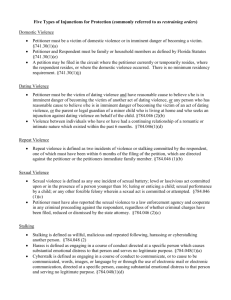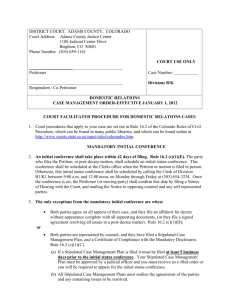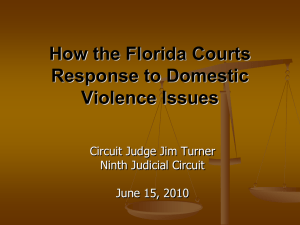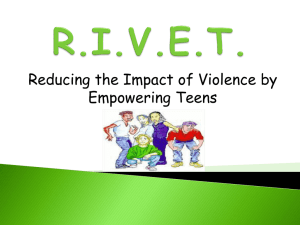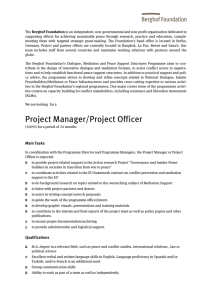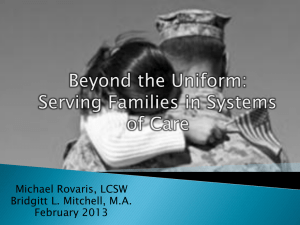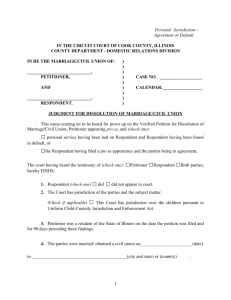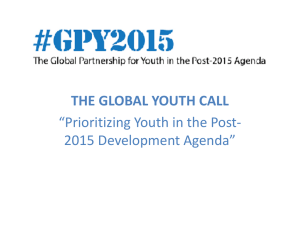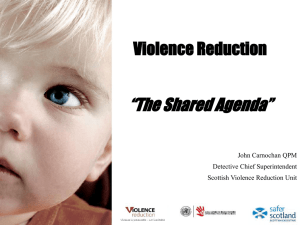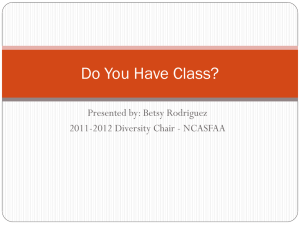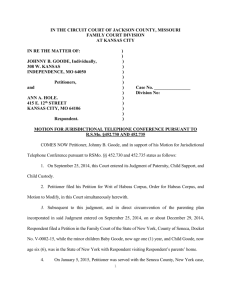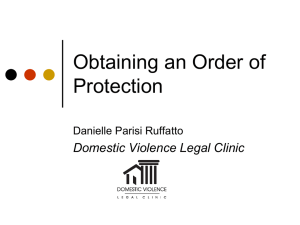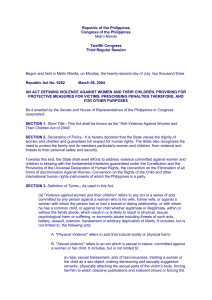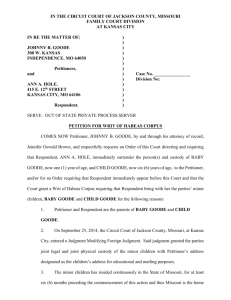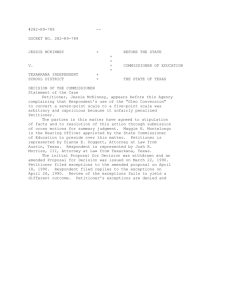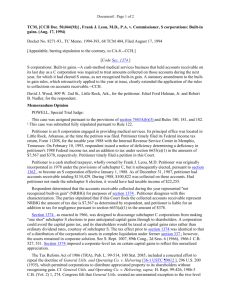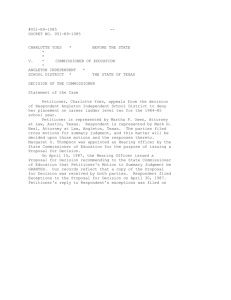PPT - Florida Courts
advertisement
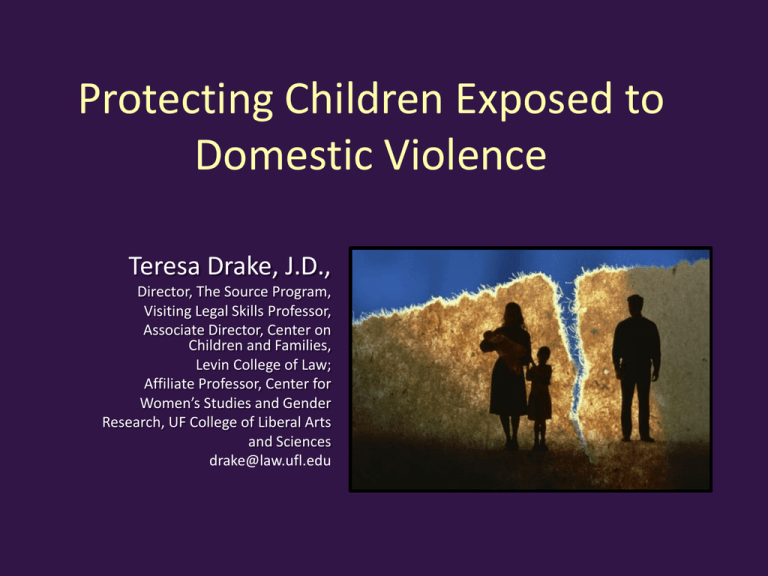
Protecting Children Exposed to Domestic Violence Teresa Drake, J.D., Director, The Source Program, Visiting Legal Skills Professor, Associate Director, Center on Children and Families, Levin College of Law; Affiliate Professor, Center for Women’s Studies and Gender Research, UF College of Liberal Arts and Sciences drake@law.ufl.edu Fla Stat 741.2902 • Legislative Intent with respect to judiciary's role – (2) It is the intent of the Legislature, with respect to injunctions for protection against domestic violence issued pursuant to s. 741.30, that the court shall: • (e) Consider supervised visitation, withholding visitation, or other arrangements for visitation that will best protect the child and petitioner from harm. Fla Stat 741.30 • (6)(a)Upon notice and hearing, when it appears to the court that the petitioner is either the victim of domestic violence as defined by s. 741.28 or has reasonable cause to believe he or she is in imminent danger of becoming a victim of domestic violence, the court may grant such relief as the court deems proper, including an injunction: – (3) On the same basis as provided in chapter 61, providing the petitioner with 100 percent of the time-sharing in a temporary parenting plan that remains in effect until the order expires or an order is entered by a court of competent jurisdiction in a pending or subsequent civil action or proceeding affecting the placement of, access to, parental time with, adoption of, or parental rights and responsibilities for the minor child. Power & Control Wheel Children and DV • In 43% of households where DV occurs, at least one child under the age of 12 lives in the home • Although many parents believe they can hide DV from children, research suggests that 80% - 90% of these children are aware of the violence • Sleeping infant study! Examples of Child Exposure • Hearing threats of physical harm • Feeling tension building in home prior to assault • Being hit/threatened while in mother’s arms • Hearing/seeing assault on their mother • Being denied care because mother is injured or depressed • Being forced to watch/participate in violence against their mother • Seeing aftermath of violent incident • Having their relationship with their non-violent parent undermined • Being taken hostage to force mother to return home • Being forced to relay messages, spy on, or monitor the mother • Experiencing the loss of a parent due to murder/suicide. The Most Dangerous Time • The most dangerous time for a battered woman is when she finally decides to leave • As many as 75% of DV calls made to police and 73% of the emergency room DV visits occur during or immediately following separation • Of women killed by their abusers, 70% are killed during the process of trying to leave. Children Witnessing DV • In approximately 19% of femicides, children are also killed • In 71% of cases a child either witnesses the femicide or is the first to find body. Children Affected by DV Children Affected by Trauma Brain Development • Brain development and growth is profoundly “front loaded” such that by age four, a child’s brain is 90% of adult size • The fastest “spurt” begins in the last trimester and is at least 83% postnatal, continuing to about 18-24 months of age. Brain Development • During this great ‘brain” growth between -9 – 4 years of life, a child’s rapidly developing brain organizes to reflect the child’s environment • Neurons, neural systems and the brain change in a “usedependent” way • Physical connections between neurons (synaptic connection) increase and strengthen through repetition, or wither through disuse…Cells that fire together, survive together, and wire together. What If Our Environment is Unsafe? Responses Affected • In a state of fear we retrieve information from the world differently than when we feel calm • In a state of calm, we use more complex parts of the brain (neocortex) to process and act on information • As perceived threat level goes up, less thoughtful and more reactive responses surface; actions are governed by emotional and reactive thinking styles (limbic and diencephalon). Base-line Stress Levels Affected • Flight or flight: hyperarousal response, may display defiance, resistance or aggression. Often display hypervigilance, anxiety, panic or increased heart rate. More common in older children, males and circumstances where trauma involved witnessing or playing an active role. • Freeze: dissociative response, may involve avoidance, withdrawing from the outside world. Child may be compliant (even robotic), display rhythmic self-soothing such as rocking. Most common in young children, females and during traumatic events characterized by pain or inability to escape. Fight, Fright or Freeze: Stuck On Trauma is Intergenerational P, Suicide “Accidental” shooting IPV victim Drug use Incarcerated Drug use Creating a Context for Children’s Healing • A sense of physical and emotional safety in current surroundings • Structure, limits and predictability • A strong bond with the nurturing, non-violent parent is one of the best predictors of a child’s ability to recover from trauma – The child must feel that the parent can protect them – The child must recover his/her respect and/or confidence in the parent – The child must feel that the surrounding social environment supports them bring close to that parent. Context for Children’s Healing, con’t • Not to feel responsible for taking care of adults • Contact with the battering parent if it can occur with adequate protection for the child’s physical and emotional safety • A strong bond to siblings. Batterer’s Manipulations After Separation: Disrupting Healing • Children can be used as primary weapon to: – Pressure partner to reunify • Sending messages through children • Parentification of children • Neglecting/abusing children – Retaliate • • • • • Threatening to obtain “custody of children” Blaming/Undermining relationship with non-violent parent Spying, Cyberstalking through children Pet abuse Sabotaging children’s relationships with therapists, medical personnel, child care • Isolating children from support/peers • Neglecting/Abusing children. Back to Injunction: The Chain of Events • Petitioner (80-85% of domestic violence survivors are women) files for injunction for protection with children • Temporary injunction is granted; petitioner is given 100% timesharing • Respondent is served and all that is seen is SHE IS LEAVING…NO ACCESS TO THE CHILDREN • Respondent loses control and blames survivor for denying his rights to his children • ….Chaos…..escalation….danger. How Can We Minimize the Danger • Demystify/Empower/De-escalate: Brochure or handout that is served on Respondent with temporary order or order setting hearing: – Explains that the temporary order is temporary – Tell Respondent he/she will get the opportunity to present evidence before Judge makes a final decision – Warns about consequence of violations – Assures Respondent that timesharing will be addressed by the Judge at the final hearing and prepares the Respondent for the possibility of mediation. Petitioner Safety • Brochure/handout given to the Petitioner when she/he applies for injunction and at the final hearing: – Describes court proceedings, including mediation and her/his ability to opt out – Outlines safety plan in home, community and courthouse – Explains reporting violations procedures – Lists community resources. In the Courtroom • Have a good working relationship between bailiffs, mediation staff, victim advocates (Fla. Stat. 741.30(6)(a)(6)) in which safety is the top priority • http://www.flcourts.org/core/fileparse.php/273/urlt/201 2DomesticViolenceBenchbook.pdf • Explain the parameters in which you will use mediation and/or dv victim advocates in the courtroom. When to Address Time-sharing • If parties are married • If paternity has been established by a circuit court • If neither, then Respondents can be guided to resources that can assist them to open a family law case • The responsibility of initiating a family law case should not be on the shoulders of the Petitioner. Determining Time Sharing: Mediation • Fla. Stat. 44.102(2)(c) In circuits in which a family mediation program has been established and upon a court finding of a dispute, (the Court) shall refer to mediation all or part of custody, visitation, or other parental responsibility issues as defined in s. 61.13. Upon motion or request of a party, a court shall not refer any case to mediation if it finds there has been a history of domestic violence that would compromise the mediation process…however, if the petitioner knowingly agrees to the process and the scope is narrowly defined… • …and if there is a victim advocate (Fla. Stat. 741.30(7)) • Cases should be referred after a final injunction has been ordered and the judge has determined that timesharing will be supervised or unsupervised. Mediation, con’t • Mediators must have specialized training in domestic violence mediations (contact Circuit 8, Beverly Graper, Graperb@circuit8.org): • Mediators review all files before court and are present in courtroom • All mediations are conducted caucus style • All mediators: • • • • • • • • • Understand the dynamics of power and control Aware of the effects of dv on children Understand survivor trauma behavior Familiar with supervised visitation center options and safe public pass-off locations Familiar with Family Wizard and other such services Uses template for “tight” high-conflict parenting plans Keenly aware of information, verbal or non-verbal, that is passed from one party to the other Have safety support to transport both themselves and petitioner to mediation suite Understand that any threat to mediator by Respondent is outside confidentiality. Assistance in Determining Time Sharing • Supervised Visitation Center • Supervised Visits with neutral third party • Safe public pass-off locations (strict timeframes) – Publix – Sheriff’s office – Banks. Child Support • Best Practices Model on Child Support in Domestic Violence Cases. http://www.flcourts.org/core /fileparse.php/260/urlt/child support_dvcases.pdf Judicial Resources • National Council of Juvenile and Family Court Judges www.ncjfcj.org • National Center for State Courts www.ncsc.org/Topics/Children-Families-andElders/Domestic-Violence/Resource-Guide • National Online Resource Center for Violence Against Women www.vawnet.org • Florida Coalition Against Domestic Violence www.fcadv.org. Thank You Teresa Drake, J.D. Director Intimate Partner Violence Assistance Clinic University of Florida Levin College of Law drake@law.ufl.edu This project was supported by Grant No.: 2009-WL-AX-0006 awarded by the Office on Violence Against Women, U.S. Department of Justice. The opinions, findings, conclusions, and recommendations expressed in this publication/program/exhibition are those of the author(s) and do not necessarily reflect the views of the Department of Justice, Office on Violence Against Women.

